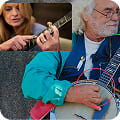Guitar Styles with Guthrie Trapp


Preview this school

Master the Guitar with Guthrie
Each lesson builds on the last, taking you from zero to hero!

Master the art of guitar with Guthrie Trapp. With 300+ lessons covering blues, funk, country, rock, reggae, and R&B, Guthrie guides you from foundational skills to advanced phrasing and improvisation. Learn to unlock the entire fretboard, develop great tone, and play with musical confidence.
Beginner Country Guitar
Build strong country skills with foundational chords, rhythm, and lead techniques.
Intermediate Country Guitar
Explore country tone and style with triads, bends, licks, solos, and strong rhythm skills to unlock the fretboard.
Advanced Country Guitar
Explore advanced country guitar concepts to improvise solos, master bends, double stops, and refine your rhythm.
Guthrie Improvisation 2022
Learn from Guthrie’s improvised solos in multiple feels and keys, with backing tracks and complete tablature.
30 Day Challenge
Getting Started
Meet your teacher and start your guitar journey with essential training on hand position, tuning, getting a good tone, and more
Fundamentals
Learn the most useful chord shapes, the major scale, and how to make smooth chord changes and play a 1-4-5 progression
The 4 Main Sounds
Guthrie breaks down his approach to playing and hearing the major, minor, dominant and major 7 sounds
Connecting Chord Shapes with CAGED
Learn the CAGED system to connect chord shapes across the fretboard, then practice with a slow blues and a funk groove
Deconstructing Chords: Triads & Arpeggios
Learn to break chords down into useful triads and arpeggios to expand your sound options and play the most important notes
Unlocking the Neck with Scales
Explore major, minor, and pentatonic scales and concepts to connect phrases and melodies across the neck
Outlining Chord Changes
Go deeper into chord relationships and melodic approaches to connect your ideas through chord changes like a pro
Phrasing & Embellishments
Learn Guthrie’s approaches to phrasing with embellishments like vibrato, string bending, and legato techniques
Putting it All Together
Combine everything covered through the course to confidently improvise solos over multiple styles of music
Get Personal Feedback with Video Exchange
Get custom video lessons from your instructor by sending a video of your playing.

How It Works?

1. Submit Your Video
Record and upload directly through our platform. No technical skills required.

2. Get Expert Feedback
Receive personal video responses from Guthrie Trapp with tips to improve!

3. Learn from Community
Browse exchanges from other students to learn from their questions.
Join Students Thriving with Guthrie Trapp!

I think ArtistWorks is really great! I would recommended everyone, who would like to play or play better! I have been playing the guitar since 25 years, and I tell, by using ArtistWorks I became a much better player only in a few months.
Marton U.
Student for 1 year
ArtistWorks is an excellent source of musical instruction. The instructional material is very complete and structured to take anyone from beginner to advanced stage of playing. You can start as a beginner, and work your way up, or jump into the intermediate, or advanced sections. It's well worth the cost for the amount of knowledge you can take from it, and it's there for you 24/7.
Martin N.
Student for 10 years
Top-notch lessons for all talent levels and student video feedback.... And ArtistWorks' customer service is great. When I had a small issue with my account, I submitted an inquiry online and Dan corrected it right away. Highly recommend ArtistWorks!
Fred C.
Student for 1 yearAbout Guitar Styles with Guthrie Trapp
Guthrie Trapp has distilled decades of professional experience into a comprehensive guitar school that covers far more than one style. With over 300 video lessons, Guthrie teaches players of all levels how to build a solid foundation, connect musical ideas across the fretboard, and develop their own expressive voice. Students explore a wide range of sounds and styles from blues, funk, and R&B to country, reggae, and rock — through a progressive curriculum that includes topics like chord construction, the CAGED system, triads, arpeggios, scales, phrasing, and musical embellishment. Each concept builds upon the next, giving you the practical skills to play fluidly, improvise and phrase solos tastefully, and make music with confidence. Lessons are supported by backing tracks, tablature, and exclusive performances offered in multiple camera angles. You’ll also join a global community of players who share your passion for guitar and musical growth. What truly sets Guthrie’s school apart is the ArtistWorks Video Exchange® learning platform. Students can submit practice videos and receive personalized video feedback directly from Guthrie. Every exchange is shared with the community, creating an ever-growing library of insights that can help unlock breakthroughs in your own playing.
About Guthrie Trapp
Growing up along the Gulf Coast, Guthrie was influenced at an early age by all the Southern musicians around him. He started playing harmonica at age 7 and then guitar and mandolin at age 10. He played in bands throughout his teens, and at age 18 recorded in Nashville for Gove Scrivenor’s acclaimed album, Shine On. In 2001 Guthrie moved to Nashville to try to make it in the country music scene. He paid dues playing with the Don Kelley Band, and soon found himself playing sessions with great musicians including Willie Weeks, Garth Brooks, Trisha Yearwood, Vince Gill, Dolly Parton, Tim O'Brien, Randy Travis, Alison Krauss, Sam Bush, Tony Rice, Earl Scruggs and more. He was a member of Jerry Douglas’ band for 5 years, and before that worked closely with Patty Loveless - including on the Grammy winning album Mountain Soul II. As a recording artist Guthrie released his first solo album called Pick Peace in 2012 as a way to showcase his signature guitar playing which has been featured on so many other musicians’ projects. His versatile playing reflects his love for all kinds of music while staying true to his country roots.
What students are saying!
Best teacher ever!!!
Guthrie Trapp is not only a world class guitarist but a humble and hardworking professional totally dedicated to his craft and teaching his students. His insights into playing guit...
Great communicator
I started watching Guthrie’s videos on YT and just wanted a more deep dive into playing over the chord change. I just started but already am seeing things that are blowing my mind ...
Master teacher but feels our pain
Guthrie Trapp is one of the preeminent guitarists of our day. Skilled in many genres and wanting to impart his knowledge to students. In the beginner course he hints at deeper leve...
Guthrie’s Trapp lessons
Really enjoying all of Guthrie’s lessons so far. Super knowledgeable guy. I’m halfway done with the intermediate section. I already knew a lot of this stuff pertaining to the “cage...
Awesome!
Perfect...exactly what I was looking for!
GT Artistworks
GT is a great instructor.
The best foundational country guitar course out there!
Guthrie gets to the heart of country guitar soloing in this incredible course. While other courses teach you licks and note for note solos, Guthrie breaks it down so you can play y...
Guthrie is a genius on
Guthrie is a genius on guitar 🎸 Explaining things so clearly thankyou From TCAPO DOWN UNDER.
It's really that good
I know you have heard it; the guy who has played for years, is a competent player, gets paid to play gigs, etc. and he says "and I learned a bunch of new stuff and new ways to appr...
GT is one of the best
I am learning a lot from GT (a top-notch guitarist). His course highlights my weaknesses and is making me a better guitarist. My goal is to someday be an accomplished guitarist as ...
4.9 Rating

